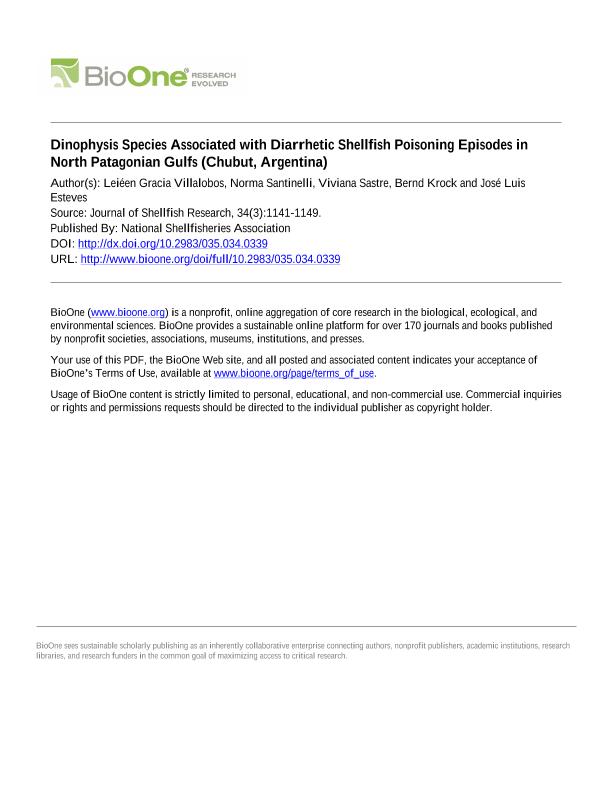Mostrar el registro sencillo del ítem
dc.contributor.author
Gracia Villalobos, Leilen Luciana

dc.contributor.author
Santinelli, Norma Herminia

dc.contributor.author
Sastre, Alicia Viviana

dc.contributor.author
Krock, Bernd
dc.contributor.author
Esteves, Jose Luis

dc.date.available
2018-05-10T16:30:21Z
dc.date.issued
2015-09
dc.identifier.citation
Gracia Villalobos, Leilen Luciana; Santinelli, Norma Herminia; Sastre, Alicia Viviana; Krock, Bernd; Esteves, Jose Luis; Dinophysis Species Associated with Diarrhetic Shellfish Poisoning Episodes in North Patagonian Gulfs (Chubut, Argentina); National Shellfisheries Association; Journal Of Shellfish Research; 34; 3; 9-2015; 1141-1149
dc.identifier.issn
0730-8000
dc.identifier.uri
http://hdl.handle.net/11336/44769
dc.description.abstract
The marine dinoflagellate genus Dinophysis Ehrenberg is globally distributed in coastal and oceanic waters and can produce lipophilic toxins. These toxins can accumulate in filter-feeding shellfish and cause diarrhetic shellfish poisoning (DSP). Between 2009 and 2011 the two most frequent and abundant Dinophysis species found in North Patagonian gulfs were Dinophysis tripos Gourret and Dinophysis acuminata Claparéde and Lachmann, and in 2015 D. tripos was the only toxic species found in moderate to high relative abundances when mouse bioassay results for DSP were positive. The positive results from mouse bioassay for DSP agree with moderate to high relative abundances of D. tripos and it was the only potentially toxic Dinophysis species found in the samples. The toxin profiles consisted mainly of pectentoxin-2 (PTX-2) followed by PTX-11 and PTX-2 seco acid. The toxin profiles of the samples could be associated with D. tripos, because the maximum proportion of D. acuminata did not exceed 1.3% of total Dinophysis cells in any of the samples. The results suggest that shellfish accumulated high levels of PTX when D. tripos was at a high abundance. To our knowledge, this is the first record of positive results in the mouse bioassay for DSP related to D. tripos and with closures of shellfish harvesting in North Patagonian gulfs.
dc.format
application/pdf
dc.language.iso
eng
dc.publisher
National Shellfisheries Association

dc.rights
info:eu-repo/semantics/openAccess
dc.rights.uri
https://creativecommons.org/licenses/by-nc-sa/2.5/ar/
dc.subject
Dinophysis Tripos
dc.subject
Dinophysis Acuminata
dc.subject
Diarrhetic Shellfish Poisoning
dc.subject
Mouse Bioassay
dc.subject
Liquid Chromatographytandem Mass Spectrometry
dc.subject
North Patagonian Gulfs
dc.subject.classification
Otras Ciencias Biológicas

dc.subject.classification
Ciencias Biológicas

dc.subject.classification
CIENCIAS NATURALES Y EXACTAS

dc.title
Dinophysis Species Associated with Diarrhetic Shellfish Poisoning Episodes in North Patagonian Gulfs (Chubut, Argentina)
dc.type
info:eu-repo/semantics/article
dc.type
info:ar-repo/semantics/artículo
dc.type
info:eu-repo/semantics/publishedVersion
dc.date.updated
2018-05-04T21:22:41Z
dc.identifier.eissn
1943-6319
dc.journal.volume
34
dc.journal.number
3
dc.journal.pagination
1141-1149
dc.journal.pais
Estados Unidos

dc.description.fil
Fil: Gracia Villalobos, Leilen Luciana. Consejo Nacional de Investigaciones Científicas y Técnicas. Centro Nacional Patagónico; Argentina
dc.description.fil
Fil: Santinelli, Norma Herminia. Universidad Nacional de la Patagonia ; Argentina
dc.description.fil
Fil: Sastre, Alicia Viviana. Universidad Nacional de la Patagonia ; Argentina
dc.description.fil
Fil: Krock, Bernd. Helmholtz Zentrum für Polar- und Meeresforschung, Chemische Ökologie. Alfred Wegener Institut; Alemania
dc.description.fil
Fil: Esteves, Jose Luis. Consejo Nacional de Investigaciones Científicas y Técnicas. Centro Nacional Patagónico; Argentina
dc.journal.title
Journal Of Shellfish Research

dc.relation.alternativeid
info:eu-repo/semantics/altIdentifier/doi/https://dx.doi.org/10.2983/035.034.0339
dc.relation.alternativeid
info:eu-repo/semantics/altIdentifier/url/http://www.bioone.org/doi/10.2983/035.034.0339
Archivos asociados
